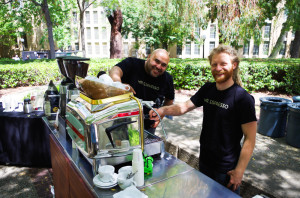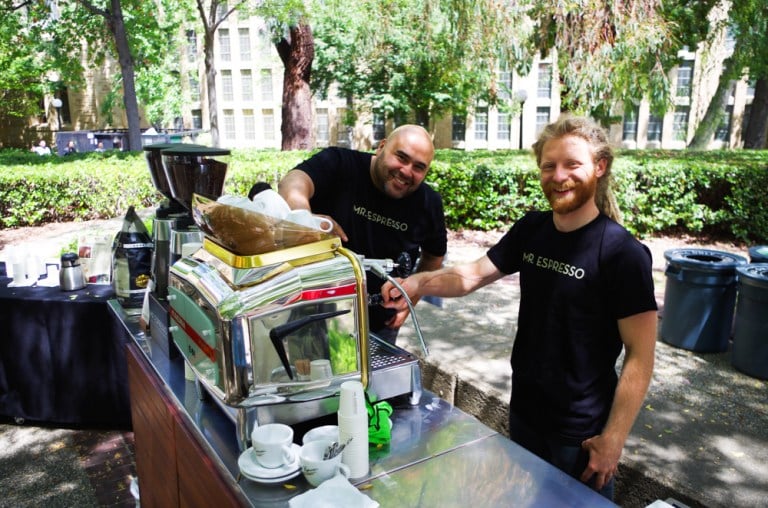
As part of its course WSP 172: “Coffee: From Tree to Beans to Brew and Everything in Between,” Stanford Continuing Studies hosted and organized the Stanford Coffee Symposium, an educational and tasting event situated outside of Green Library, on Saturday morning.
The event, which offered a continuation from the class’ content, aimed to help attendees learn more about coffee’s role in the economy, history, biology and brewing techniques and varieties.
The coffee symposium was the result of 18 months of thought and planning, according to Greg Sherwin, one of the event’s co-organizers. Professor of Biology Virginia Walbot ’67 had previously invited Sherwin to create an event that Walbot had arranged at Stanford a few years prior.
“[It was an event] for chocolate,” he said. “[This year’s event] tied into a lot of Stanford connections with Latin American Studies, economics, biology and so on. It is a showcase for academia as well as industry and consumers about coffee, interest in coffee and all the factors it touches on.”
The coffee symposium included offering attendees samples of different kinds of professionally barista-brewed coffees and coffee beverages. Samples included freshly brewed coffees from Bay Area coffee houses such as Café Venetia, Blue Bottle Coffee and Barefoot Coffee Roasters. Coupa Café was also one of the vendors offering samples and tasting.
“In this event, we are here to showcase different coffee grounds and brewing methods,” said Julio Cesar, who works at Coupa Café and who represented the chain at the event.
“Coupa Café is coffee from Venezuela – the beans come straight from Venezuela,” Cesar said. “Here in the Bay Area, we were the first coffee shop to serve authentic Venezuelan coffee.”
Sherwin explained that one of the goals of the event was to help educate attendees about the flavors and varieties of coffees, in addition to other issues related to biology and agriculture.
“You can’t just talk about coffee and not have it – these guys are here to help us enjoy it as well,” Sherwin said, in reference to the representatives from coffee houses and their sample selections at the event.
One of the other highlights of the event was a coffee tasting program run by Blue Bottle Coffee, a famous San Francisco coffee company.
Stephen Vick, the coffee buyer at Blue Bottle Coffee, was one of the many representatives arranging the event.
“This portion of the event is a tasting event,” he said. “We’re going to be tasting three very different coffees that are processed in different ways. There is a whole lot of factors that affect how coffee tastes, from how it’s grown, to the soil, to the variety.”
The tasting program was centered around a blind tasting of three different coffees and culminated in a talk on the properties of coffee and the nature and function of different brewing techniques.
“The idea is to, at the end of the day, talk about the properties of the coffee,” Vick said.
The event sold out, drawing a large crowd of Stanford community members, students and local residents. Sherwin attributed the popularity of the event to an increased interest in high-value coffee.
“In the last 12 years, [specialty and high-end coffee] has really blossomed because people have realized that there really is something to higher-value coffee,” he said. “I think this event represents a lot of that and what better coffee could be.”
Contact Nitish Kulkarni at nitishk2 ‘at’ stanford ‘dot’ edu.
